The first ultrarunning World Championships were created in 1987 when the International Association of Ultrarunners (IAU) held the inaugural 100km World Championships in Torhout, Belgium. What attracted top-class ultrarunners like Eleanor Adams to take part in this new event?
By the time of the first World Championships Eleanor Adams had already achieved dozens of world best times and performances over a range of ultra marathon distances and she had won many races. She had not thought that there would ever be world titles in ultrarunning and the opportunity to win a world title, along with the opportunity to represent Great Britain, made the event one she wanted to enter.
1988 – 100km World Championships, Santander, Spain
Eleanor Adams was the first British woman to compete in the IAU 100km Championships. She won the bronze medal in the 1988 Championships in Santander, Spain, finishing in 8.07.36 a world age best for W40. Ann Trason from Oakland, California, running her first 100km race, won in an outstanding time of 7:30:49, a world best for a certified course, finishing more than 25 minutes ahead of Marta Vass of Hungary (7:56:07).
Adams competed in the 1989 Championships at Rambouillet, France, alongside Hilary Walker who won Bronze. The race started at 4am to avoid the worst of the traffic. Andy Milroy reported that the women’s race took a dramatic turn. Adams was leading at 50km, but unfortunately took a wrong turn, lost twenty minutes and dropped from first to fourth. The weather was hot and Adams became dehydrated and had what she described as “a shocking run”, finishing 11th in 9:36:08. Later that year, she won the 100km Internacionales de Cantabria in Santander, Spain, in 7:48:33, her best time. This places her 9th in today’s GB rankings.
1990 – 100km World Championships, Duluth, Minnesota, USA
In 1990, Adams was in the ninth year of her ultrarunning career. In what was a fairly typical year for her, by the time of the IAU 100km race in October, she had already competed in 42 races, including the 6-day Tour of Tameside. Adams raced at all distances from 5km upwards. Her races were mainly road with a few cross country, fell and trail events. She had run seven marathons, finishing first in Manila, Derby, Guernsey and the Long Distance Walkers Association (LDWA) Charnwood Forest Marathon and setting a personal best time of 2:45:12 at the London Marathon in April.
Her ultramarathons in 1990 (female placings) were:
- February – the International 24 Hour Championship (indoor) in Milton Keynes – first
- March – Valenciennes 100km, France – first
- April – Surgeres 48 Hour track race, France – second
- June – Torhout Nacht Van Vlaanderen (Night of Flanders) 100km, Belgium – second
- July – Lyke Wake 40 mile trail race – first
- September – LDWA Bullock Smithy 56 miles trail – first, course record
The Milton Keynes 24 Hour Championship was an international event organised by the Road Runners Club (UK) and was later designated as the first IAU 24 Hour Championships. Adams is the only runner to have won both the 24 Hour and 100km Championships in the same year.
The fourth IAU 100km World Championships were held at the Edward Fitzgerald 100k Road Race in Duluth, Minnesota on 27th October 1990. It was a point to point race and relay along the north shore of Lake Superior. Founded in 1982 by Bill Wenmark, the event continued until 2006.
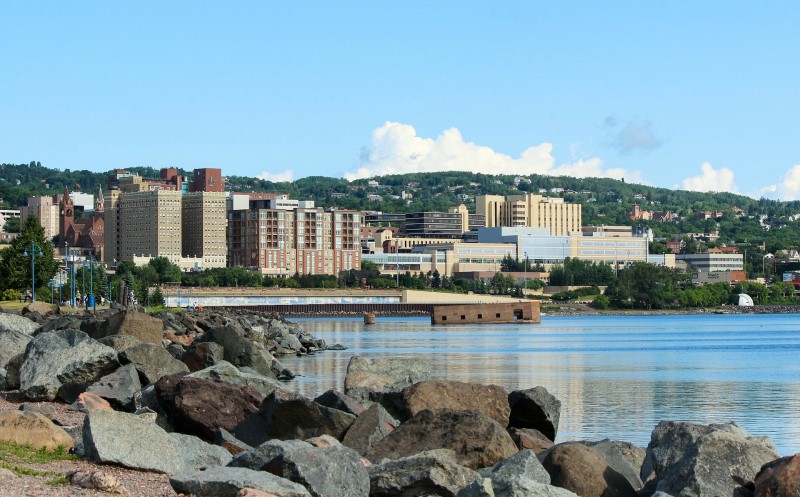
Duluth waterfront, 2013
In 1990, Ann Trason was the favourite to win in Duluth. At 42, Adams was twelve years older than Trason. Adams had not intended to go to the event but received a personal invitation from Bill Wenmark. She was also encouraged to attend by John Legge, the selector of the GB team. It was the chance to officially represent Great Britain that decided her to go
Eleanor Adams was the only British woman to finish the race that year. Looking back on the race, Adams wrote in 2001:
Duluth is the only championship to be held in cold conditions and I remember it as being very cold. I led from early on but the opposition was very strong. Following a rough off-road section at about 50km, I damaged my knee. I completed the race expecting to be overtaken at any time, not knowing that my rivals were also suffering or having any information as to their whereabouts. The early championship events lacked the sophisticated support systems that we are now used to. It was with enormous pleasure that I became 100km world champion for the first time.
The finishing times were:
- Eleanor Adams 7:55:08
- Ann Trason 8:06:15
- Marta Vass 8:07:18
1991 – 100km World Championships, Faenza, Italy
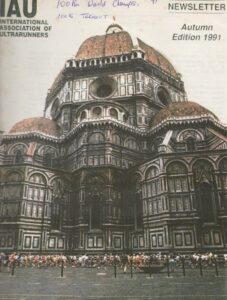
Runners pass in front of the Cathedral of Santa Maria del Fiore in Florence
Eleanor Adams re-married in December 1990, becoming Eleanor Robinson. Now in the tenth year of her ultrarunning career, she had already competed in 21 races, cross country, road and fell, by the time of the 100km World Championships in May. She had won the Malta Marathon in February, Langbaurgh Marathon in March and Edinburgh Marathon in May. Her only ultra race had been the Madrid 100km which she had won in 7:52:04.
The fifth IAU 100km Championships were held on 25th May at the 19th 100km Del Passatore race. Starting in Florence, the course wound its way up over the Apennines, and down to the finish in Faenza. The race still takes place today. It was a mass ultra marathon with 1,156 finishers, mostly Italian men. Only 6% of the finishers were women.
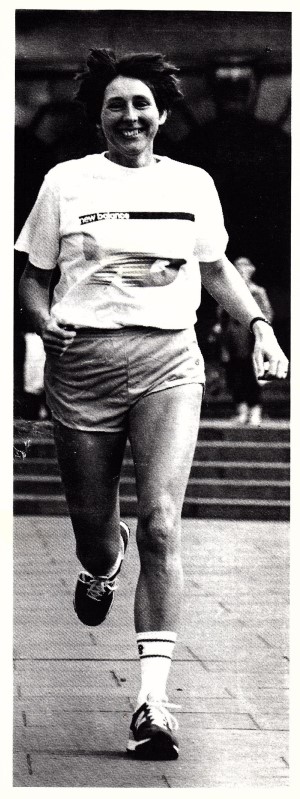
Many thousands of spectators lined the route and some attempted to follow the race by bicycle or car. The event was filmed by Italian television channel RAI as well as Japanese channel Fuji Television. Youtube has two film segments from RAI Uno. One shows the start and the leading men reaching the top of the first hill. The second segment shows the finish of the men’s race. This was in the dark as the race had started at 4pm. There appears to be hundreds of people waiting at the finish. Right at the end of this segment, there is a brief clip of Eleanor Robinson finishing, being congratulated by other runners and given flowers and a medal.
Andy Milroy reported on the race in detail in the Autumn edition of the IAU Newsletter. He commented that “the elite field was dominated by strong teams from the American, British, French, German and Soviet federations“. It was the first time that a team from the USSR had competed.
This is Milroy’s account of the women’s race:
The early leader was Marta Vass of Hungary, who led to the 5km point before Nadezhda Gumerova took over. The Russian led up the first hill until 20km but defending champion, Eleanor Adams-Robinson, always had her in her sights. As they crested the first hill at 20km Eleanor took the lead which she quickly stretched to a three minute gap. Marta Vass was some three to five minutes back in third.
These gaps between the leading runners remained the same as the runners made their way up the long zig-zag climb to the top of the pass. On the long downhill after Colla di Casglia, the 50km point, the gaps between the tiring runners began to stretch out. By the time Eleanor reached Faenza, and the finish, she had a thirteen minute lead over Nadezhda Gumerova, with Marta Vass a further ten minutes back.
Eleanor’s final time of 7:52:15 was a new course record. The quality of this run is revealed in the fact that she left Tomas Rusek and Boris Bakmaz behind her, both men usually consistent sub-7 hour runners. Perhaps more significantly from Eleanor’s point of view, she became the first woman to retain the World Cup title, a feat that only Domingo Catalan of Spain, amongst the men, has achieved. Eleanor said afterwards that she had run to her own race plan, running well within herself for the first 50km with the intention of putting the pressure on over the second half.
Looking back on the race in 2001, Eleanor Robinson wrote:
It was very hot in Italy and definitely not my preferred running conditions. A formidable Russian women’s team was competing for the first time, many of whom were fast marathon runners but unproven over 100km. Once again support en route was non-existent as the GB team had only one manager who was assigned to the men. I will remember receiving great help and encouragement from other team managers; the heat; the beautiful scenery as we climbed up and up the mountain side and the dreadful traffic – too many cars and bicycles – on a very narrow switchback road. I also remember well the companionship of running the final stretch with Tomas Rusek (CZE).
This was one race run in the heat when I was not affected by sickness; a problem which would blight most of my other championship efforts and prevent me from achieving all I hoped for.
The finishing times were:
- Eleanor Robinson 7:52:15
- Nadezhda Gumerova (Russia) 8:05:47
- Marta Vass 8:15:28
The British women’s team of Eleanor Adams, Susan Ashley (12th) and Hilary Walker (13th) were second, behind the German team.
After 30 events, Eleanor Robinson remains the only woman to have successfully defended the World Champion title.
Other IAU 100km World Championships performances
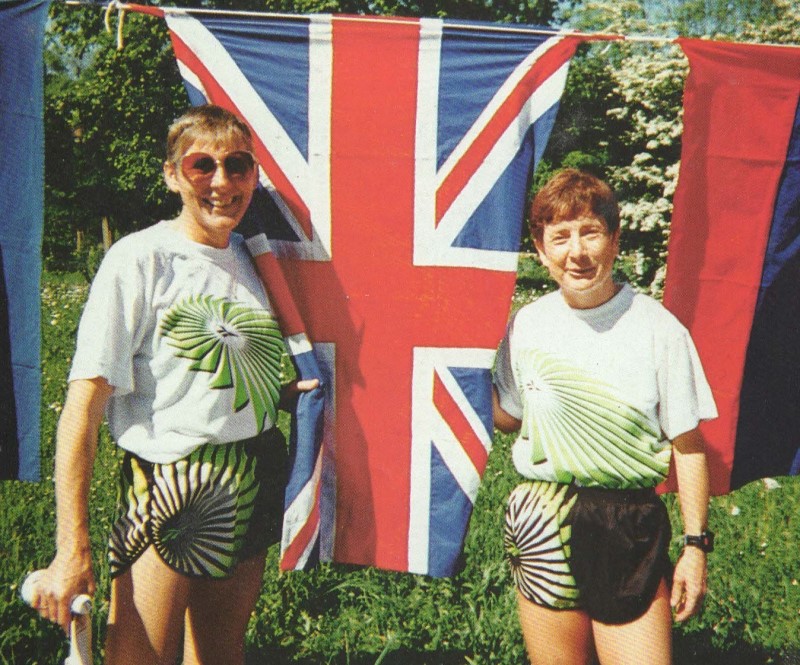
Eleanor Robinson competed in the World Championships seven times. The first four performances, 1988-1991, are described above. Robinson did not defend her title in 1992 as she had given birth to her fourth child in December 1991.
Robinson was also selected to run for GB in 1995 at Winschoten where she placed 10th in 7:50:42 and was first W45. In 1996, Britain did not send a team to the tenth Championships in Moscow.
In 1997, Robinson finished 7th and first W45 at Winschoten in 7:56:33.
At Shimanto in Japan, in 1998, Carolyn Hunter-Rowe took Gold for the second time. Robinson, aged 50, finished 28th in 9:59:14. She recorded in her diary that she had struggled in the 30 degrees centigrade heat and that this was her worst ever 100km time.
Supporting the GB team
Eleanor Robinson has served both as a selector for the GB team and as one of the team managers. In 2014 in Doha, Robinson was on the management team along with Adrian Stott and Walter Hill when Ellie Greenwood won Gold for the second time and Joasia Zakrzewski won Bronze. Jo Meek placed fourth ensuring a team Gold for the British women.
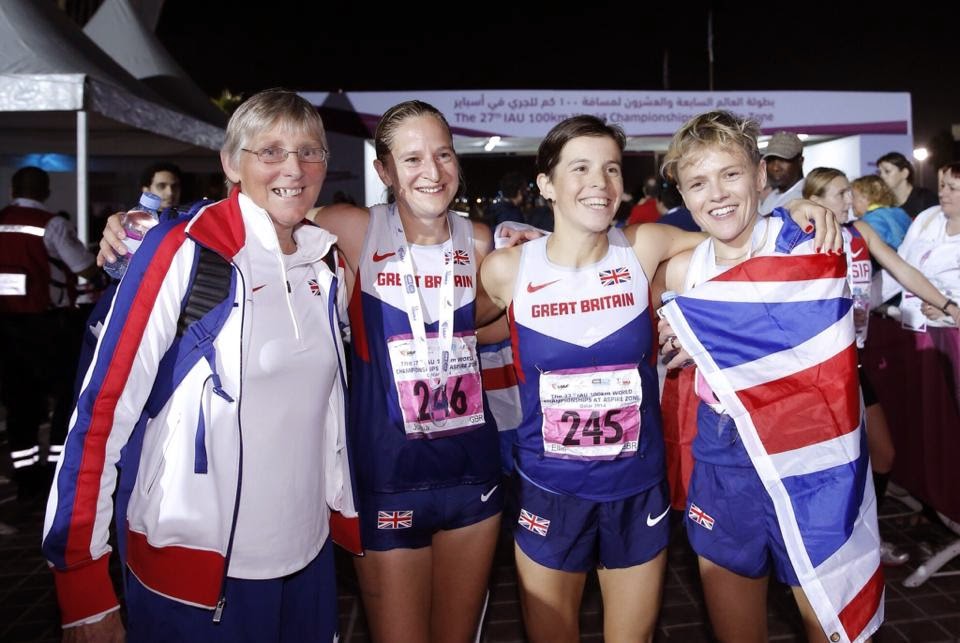
Eleanor Robinson, Joasia Zakrzewski, Ellie Greenwood and Jo Meek at the 2014 World Championships in Doha
What winning means
In 1990 and 1991 Eleanor Robinson was at the mid-point of her ultrarunning career and was about to be out of elite competition for a year due to pregnancy and the birth of her fourth child, Myles, in December 1991. Over the course of her career, she achieved many world best performances, perhaps more than any other ultrarunner, but her world titles have a special significance.
World titles are things that nobody can take away. It shows that I was the world champion and the best in the world at that time.
This is why she chose these two races to feature amongst her top ten performances when she was inducted into the IAU Hall of Fame in 2001.
Notes
The IAU 100km World Championships have been held most years since 1987. The 30th event was held in Croatia in 2018. Now a biennial event, the 2020 Championships were due to be held in Winschoten in the Netherlands in September but were cancelled due to the coronavirus pandemic.
British women have been very successful at the IAU 100km World Championships, winning 15 individual medals and six team medals. Read more about the other British competitors here: British women’s success at the 100km World Championships.
Read about the other races that Eleanor Robinson chose as her top ten performances:
Westfield Sydney to Melbourne 1983
New York 6 Day Race 1984
Colac 6 Day Race 1984
The first Badwater ultra race 1987
Melbourne 24 Hour Track Race 1989
IAU International 24 Hour Championships Milton Keynes 1990
Telecom Tasmania Run 1994
Nanango 1000 Mile Track Race 1998
and another race that did not make it into the top ten:
1983 The first Spartathlon
Sources:
Interviews with Eleanor Robinson, June 2018 and May 2019.
International Association of Ultrarunners newsletters
Report on the City of Santander 100km Second IAU World Championships, by Andy Milroy, 1st October 1988, IAU Newsletter.
Report on the Paris IAU 100km World Championships, by Andy Milroy, Road Runners Club, January 1990.
Report on the IAU 100km Ultradistance World Cup by Andy Milroy, IAU Newsletter, Autumn 1991.
RAI Uno TV coverage of the finish of the 100km Del Passatore race, showing Eleanor Robinson’s finish (7 minutes in).
Women’s all-time 100km rankings, RunBritain rankings website.
Ultra Marathon Statistics, Deutsche Ultramarathon Vereinigung website.
Results and medals tables, IAU 100km World Championships, Wikipedia.
With thanks to Eleanor Robinson for lending me copies of the IAU Newsletters.
Photographs
Duluth waterfront image by JamesDeMers from Pixabay
Eleanor Robinson after her 1991 victory in Faenza from the cover of the IAU Newsletter, Summer 1991
Eleanor Robinson and Hilary Walker in 1997 from the cover of the IAU Newsletter, September 1997
Doha 2014 team photo courtesy of Ellie Greenwood.
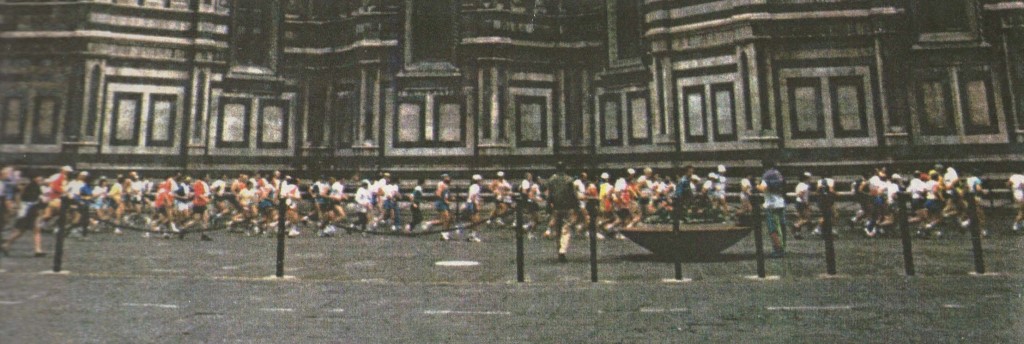
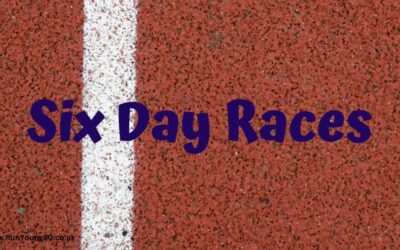
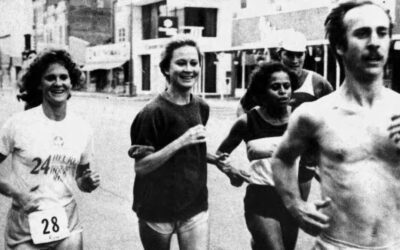
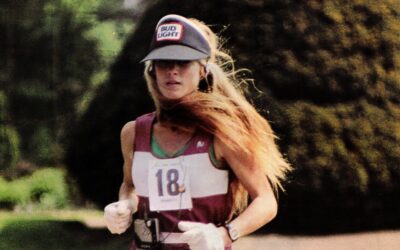
0 Comments
Trackbacks/Pingbacks